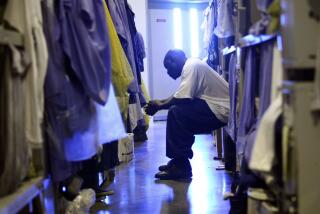More than 1,500 California jail inmates are released early
- Share via
More than 1,500 inmates have been released from county jails around California in response to legislation designed to cut the state prison population, prompting an outcry from some law enforcement officials.
More than 300 inmates have been released in Orange County in the last few weeks and about 200 in Sacramento County, including a man who allegedly assaulted a woman hours after getting early release from jail.
A Sacramento County judge Wednesday ordered a temporary halt in that county’s early releases, saying the legislation applies only to state prisons and not to county jails. The judge sided with the deputy sheriff’s union, which filed suit against the Sacramento County Sheriff’s Department to block the releases.
Officials in Sacramento, Orange, Riverside, San Bernardino, Ventura and other counties have said their legal counsels advised them that the law did apply to county jails, and they created release plans when the law took effect in January.
The Los Angeles County Sheriff’s Department takes the opposite position and has not released any inmates early because of the law. L.A. County requires that most male inmates serve 80% of their sentence, and officials said they won’t reduce that requirement because of the new law.
“We have no plans to release anyone from county jail based on what the state is doing,” said Steve Whitmore, a sheriff’s spokesman. “We don’t think it applies to us.”
The legislation, signed by Gov. Arnold Schwarzenegger last year, was designed to reduce the state prison population in the wake of the state’s financial crisis and court rulings over prison overcrowding.
Officials have said the law would reduce the prison population by 6,500 “low- level” offenders from state prisons over the next year (those would include inmates incarcerated for nonviolent crimes such as theft and drug possession).
The state prison system has not yet released prisoners early under the terms of the law.
The law changes the formula by which prisoners receive time off for good behavior, speeding the process under which they can be released.
David Tennessan, chief deputy of the Ventura County Sheriff’s Department, said his agency has had no choice but to release 200 inmates in recent weeks. But the agency has not done so happily, he said.
“It was misguided,” Tennessan said, adding that he expects Ventura County to ultimately release at least 600 inmates.
In San Bernardino County, 648 inmates have been released so far, according to the Sheriff’s Department.
In Riverside County, more than 170 inmates have been released, officials said.
But the greatest outcry has been in Sacramento County.
The Sheriff’s Department there started releasing inmates two weeks ago. The deputies’ union filed a lawsuit to block the releases. And Judge Loren E. McMaster on Wednesday agreed to a temporary restraining order, calling the releases a “formula for disaster.”
McMaster ruled that the law was never intended to apply to county inmates and that the releases pose a public safety risk.
He will consider the matter again at a hearing next month.
Although some law enforcement officials are not happy about the early releases, they also questioned the logic of McMaster’s decision.
Dennis Christy, San Bernardino County’s assistant district attorney, said the state law clearly applies to county jail inmates as well as state prisoners.
He said the legislation amended Section 4019 of California Penal Code, which directly addresses county jail inmates.
“I don’t understand how the amended section cannot apply to county jail inmates,” Christy said. “The section the new law amended deals with county inmates.”
Tehama County Sheriff Clay Parker, who also serves as president of the California State Sheriff’s Assn., said Wednesday that a survey by his organization found that 29 county sheriff’s departments have released 944 inmates because of the law.
(The Times found the number to be well over 1,000 inmates).
“It’s really tough for us because the law is not black and white,” Parker said.
More to Read
Sign up for Essential California
The most important California stories and recommendations in your inbox every morning.
You may occasionally receive promotional content from the Los Angeles Times.














